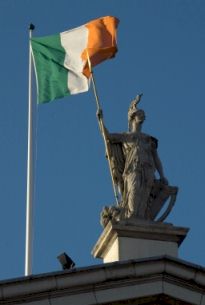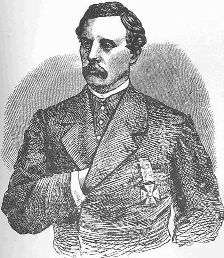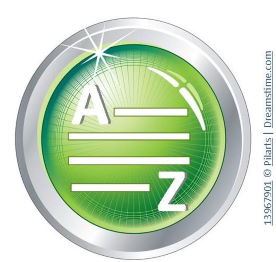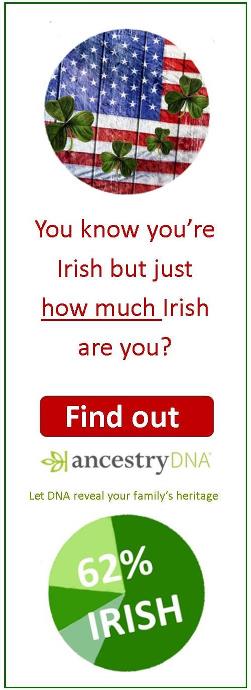- Home ›
- Irish Symbols ›
- Flag of Ireland
The flag of Ireland - a symbol of hope and peace
The tricolor was not adopted as the official flag of Ireland until after the country became a free state on 6th December 1921. But it had been around for nearly 80 years, albeit with its colours rearranged, having first been flown by Thomas Francis Meagher, a militant nationalist, in 1848.

This was the beginning of the Young Irelander Rebellion, which took place at the height of the Great Hunger in Ireland and shortly after King Louis-Philippe of France, and a good few other European monarchs and despots were overthrown by popular insurrection. The Young Irelanders believed the time had come for revolution in Ireland and launched an unsuccessful rebellion that summer.
Thomas Meagher and the other leaders were initially sentenced to death but their sentences were later commuted to transportation to Australia.
While they were unsuccessful in their revolution, their flag now flies as the ultimate of all symbols of Ireland.
The green of the flag of Ireland
It is often assumed that the colour green on the flag of Ireland symbolises the famously verdant landscape of the 'Emerald Isle'.
In fact, green had long been the colour used in flags by the Catholic majority in their fight to gain independence from Britain.

An earlier flag, with a gold harp on a green background, served from 1798 until the early 20th century as a symbol of nationalism. It is now the flag of Ireland's Leinster province and is known as the Arms of Ireland.
The orange of the flag of Ireland
The orange of the tricolour represents the Protestant minority who were settled into Ireland by the British monarchy from the mid-1550s. It is also a reminder of Protestant William of Orange's defeat of the exiled Catholic King James II at the Battle of the Boyne in 1690. In the lead up to that battle, King James II had proved to have none of the 'people skills' of his elder brother, King Charles II, whom he succeeded on the throne of England, Scotland and Ireland in 1685.
As a Catholic king in Protestant England and Scotland, he provoked enormous opposition when he began actively trying to promote Catholicism across his realm. His behaviour led to his being deposed within three years in favour of his Protestant daughter Mary and her Dutch husband William of Orange. They ruled jointly as King William III and Queen Mary II from 1688.
Never one to know when to give up, James was easily convinced by Irish Catholics to launch his campaign to win back his crown from Ireland a year later. Having lost Derry (Londonderry) after a two-month seige, he was defeated at the Boyne by William III in July 1690 and fled to France where he lived out the rest of his days.
William's victory secured Protestant dominance in Ireland but a century later the Anglican (English) and Presbyterian (Scottish) settlers were feeling threatened by Catholic nationalism. In 1795 the Orange Order was founded and grew increasingly strong over the next sixty or so years amid Protestant fears that their dominance would end if the island were granted Home Rule or even Independence from the Britain.
The white of the flag of Ireland
The tricolour made its first public outing at the Wolfe Tone Confederate Club on 7th March 1848. The twenty-four-year-old nationalist Thomas Meagher, son of the city's mayor, made a speech to explain the symbolism of the three colours.
He said: "The white in the centre signifies a lasting truce between the Orange and the Green, and I trust that beneath its folds, the hands of the Irish Protestant and the Irish Catholic may be clasped in generous and heroic brotherhood."
 Thomas Meagher went on to become Brigadier General of the Irish Brigade and Governor of Montana after escaping from Tasmania
Thomas Meagher went on to become Brigadier General of the Irish Brigade and Governor of Montana after escaping from TasmaniaAlthough Meagher is usually described as the designer of the flag, there is no evidence to suggest he was. All that is known is that after a visit to Paris, where he congratulated ministers for their their successful revolution, he returned with the tricolor to Ireland. It is not known whether the flag was a gift of the French or had been designed by the Young Irelanders after being inspired by the French flag.
Whatever the truth, Meagher's flag was presented to Dublin a week after its first airing during a meeting that advocated the use of physical force in the cause of independence. Days later, Meagher and two of his Young Irelander colleagues were arrested for sedition. The summer rebellion failed.
Meagher's flag was revived by the Irish Volunteers and in the Easter Rising of 1916, it was raised above the General Post Office in Dublin's main boulevard, O'Connell Street, while the proclamation of the Irish Republic was read out on the steps below.
Today, it is the flag of the Republic of Ireland, though Meagher's version had the orange stripe closest to the staff, while the modern version has the green stripe in that position.
Find out more about the symbols of Ireland.
Return to the Irish Genealogy Toolkit Home page.


